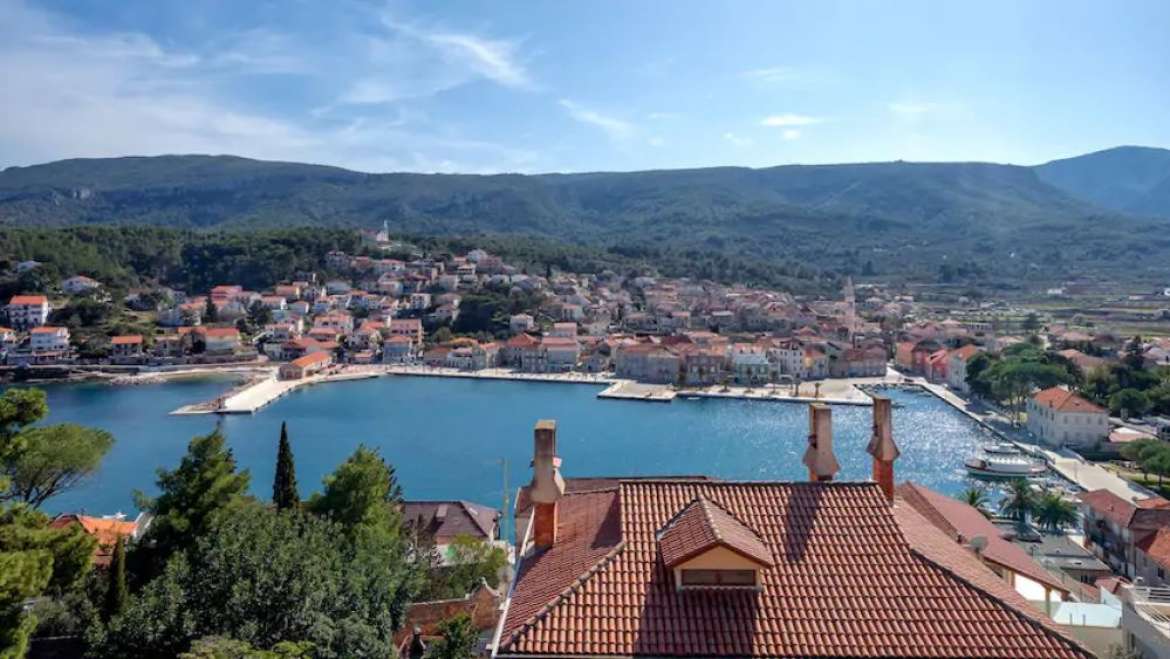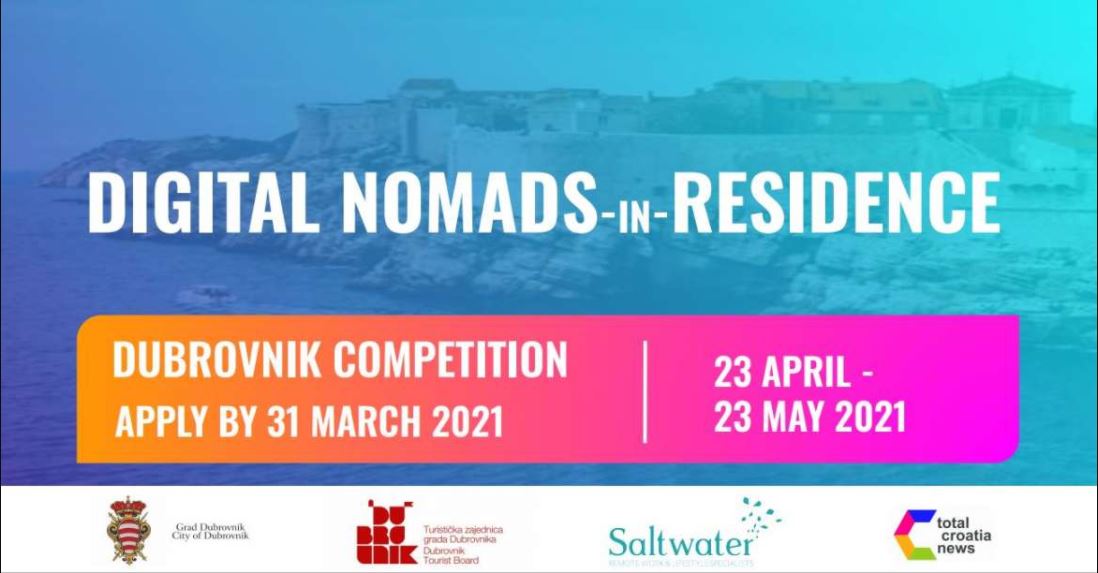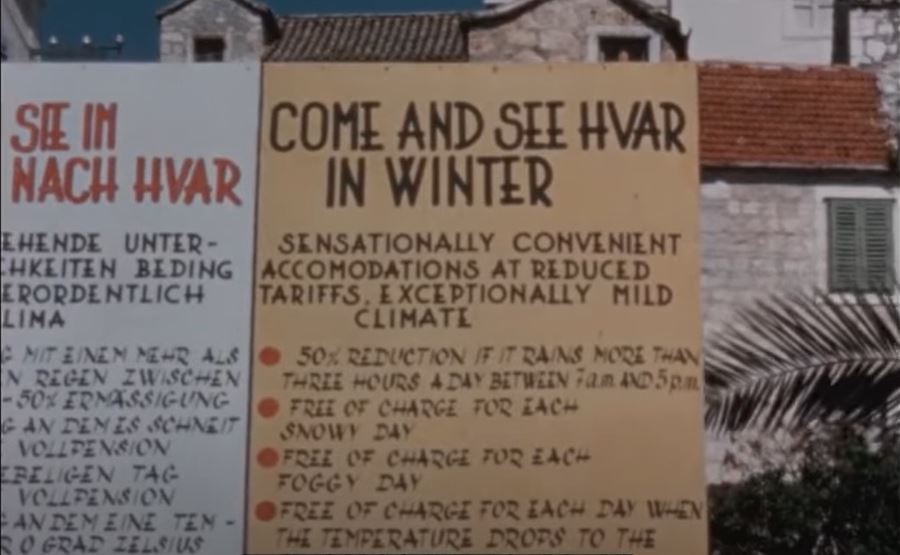2021 Goes Green: All You Need to Know About St. Patrick’s Day in Croatia
March 17, 2021 - As the final arrangements are being finalized to celebrate Saint Patrick's Day one more year in several countries around the globe, here is everything you need to know about how one of the world’s most popular holidays will be celebrated in Croatia.
Each 17th of March, the Irish population and the Irish diaspora around the world commemorate the death of St. Patrick, the patron saint of Ireland, and the arrival of Christianity there. The holiday has evolved over time to become a worldwide display and celebration of Irish culture, through colorful parades, special foods, dancing, drinking, and very importantly, a whole lot of GREEN.
Although there will be no mass parades and celebrations this year due to the COVID-19 situation, Tourism Ireland is ensuring that this important day can be celebrated safely all around the world. As a matter of fact, they’re proud to announce that a record has been set in their 12th annual ‘‘Global Greening’’ initiative here in Croatia, both in municipalities and the number of sites participating. Thus elevating the number of municipalities to nine (9), and the sites across the country to fourteen (14). Next, we will share the details of the celebrations that will be held in each of them:
- Zagreb: the Croatian capital is going ‘‘green’’ for the fifth time this year. Among the sites that will change their colors will be the Zagreb fountains, the Museum of Contemporary Arts, the Klović Palace Gallery, and the Meštrović Pavilion.
- Rijeka: also remains a strong supporter of the ‘‘Global Greening’’: Trsat Castle, the ‘‘Molo Longo’’ port cranes, and the fountain in the Adriatic Square will once again link Croatia and Ireland.
- Split: the Dalmatian city will light up its fountain in front of Prokurative.
- Dubrovnik: for the very first time, the ‘‘Pearl of the Adriatic’’ will include the Small Onofrio Fountain in the celebration.
- Zadar: this year, its ‘‘greening’’ will be moved to the ‘‘Greetings to the Sun’’ installation.
- Pula: the Istrian city is also changing its contribution this year - the roundabout at the entrance to the city will show its citizens and visitors that the city celebrates its Irish link.
- Varaždin: the northern city is back for a second time, as the Croatian National Theatre will be the city’s ‘‘green representative’’ this year.
- Hvar: it is one of the two Croatian newcomers to the initiative, and its Fortica will be quite a sight in their first year celebrating St. Patrick's Day.
- Oriovac: the other first-time participant and the only Slavonian municipality taking part, will green its Turkish fountain.
When will you be able to witness the greenings of the fourteen sites across the country? On St. Patrick’s Day, Wednesday, 17 March at 19:00! Be sure to be there at nightfall with your camera, and the right company!
More information on the 12th annual Global Greening initiative can be found at Tourism Ireland’s site.
For additional information regarding the Global Greening in Croatia, feel free to contact Bernard Vrban, Public Affairs Officer, at +385 (0)91 627 8934 or This email address is being protected from spambots. You need JavaScript enabled to view it..
For more about lifestyle in Croatia, follow TCN's dedicated page.
Americans in Croatia: From Short Hvar Stay to Digital Nomad Visa Success
March 7, 2021 - Americans in Croatia are very welcome guests, and many would come for long if it was possible. It is now, if you are a remote worker. Meet Jessica Romano from San Francisco, officially the first approved digital nomad on Hvar. Congrats and welcome!
"As you probably know, Paul, Americans in Croatia can only stay for a limited time. We LOVE Jelsa, and your apartment is really great, and we would rent it through the winter if we could stay. I read on TCN about this digital nomad visa? Is it coming soon? Do you think I could get one?"
Americans in Croatia - from a temporary stay in Jelsa to a 12-month permit.
That was back in early November when Jess and Thibaud rented our Panorama Penthouse Jelsa apartment for a couple of months. Some nice and unexpected income so late in the year. And there would be more rental income out of season if they were allowed to stay longer. Currently, Americans in Croatia can only stay 90 days at one time.
So there we were, in a situation where we both wanted to engage with Croatian bureaucracy (my favourite hobby) to get a result for Jess. She and Thibaud are amazingly thoughtful and respectful guests, even baking cookies for my punica, which makes me a little bit cooler in my punica's eyes by association.
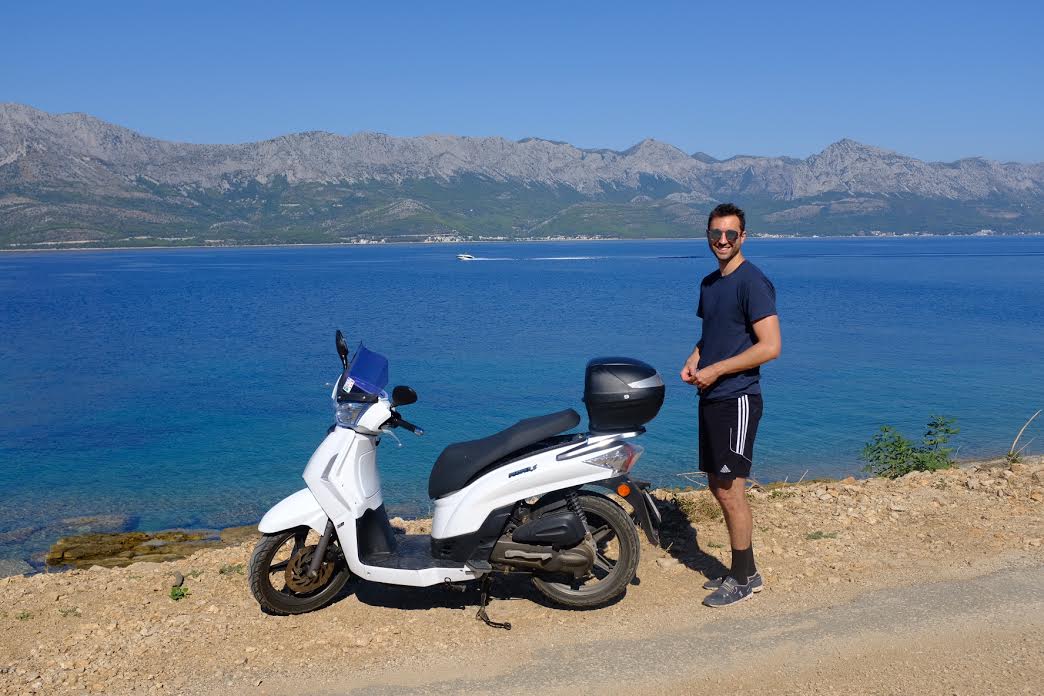
I helped where I could, as did several others. It seems that Jess and Thibaud have been a hit in the Jelsa community, helping several people, as well as bringing a little colour and fresh perspective to the long Dalmatian winter.
And yesterday, some great news, as Jess informed me that she heard back from the authorities at MUP and has been approved for a 12-month stay.
Great news and congrats. Jess kindly took the time to tell me more about, winter in Jelsa, and what the visa means for her.
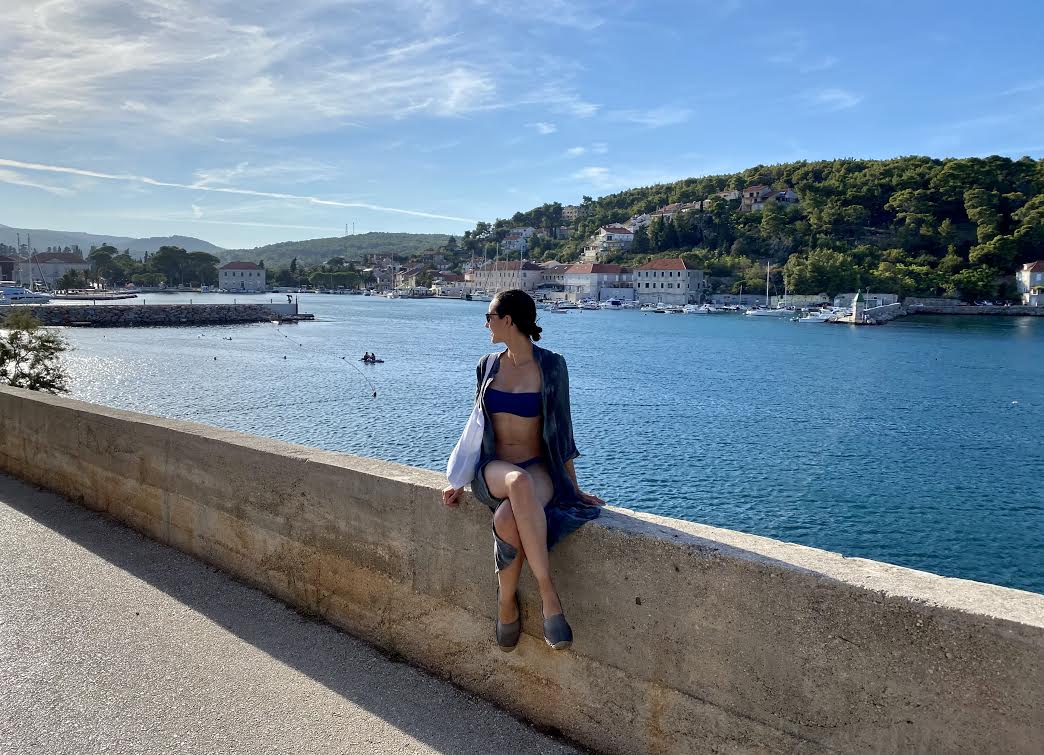
Firstly, how are you enjoying winter on Hvar? Has the reality been a little different to what you were expecting? In what way?
I’ve been enjoying it - Hvar is beautiful year-round! I didn’t have many expectations heading into the season, especially as Covid-19 dragged on into 2021. Due to pandemic restrictions, most restaurants and cafes were closed, and people haven’t been out very much. Since this is my first winter season on the island, I don’t have a point of comparison; generally, the slow pace and absence of crowds has been great. The weather and temperature has been mostly mild, but I was surprised by 1-2 week-long rainy stints. We are familiar with jugo and bura by now. I told friends here that I’ve felt quite tired during jugo, and they said that I’m officially a local now. Alas, those cloudy periods make the sunny days even more wonderful. It can get quite warm when the sun is out - if you haven’t looked at the calendar, you might think it’s summer at times! I’ve spent a lot of time outdoors - hiking, walking, rock climbing & running - and recently bought a car to explore the island. I feel as though you could live on Hvar for years and not discover all of the unique villages, ruins, beaches and trails here. Even though most wineries are closed in the winter, some offer tastings by appointment, and I’ve stopped by local producers to pick up bottles to enjoy at home.
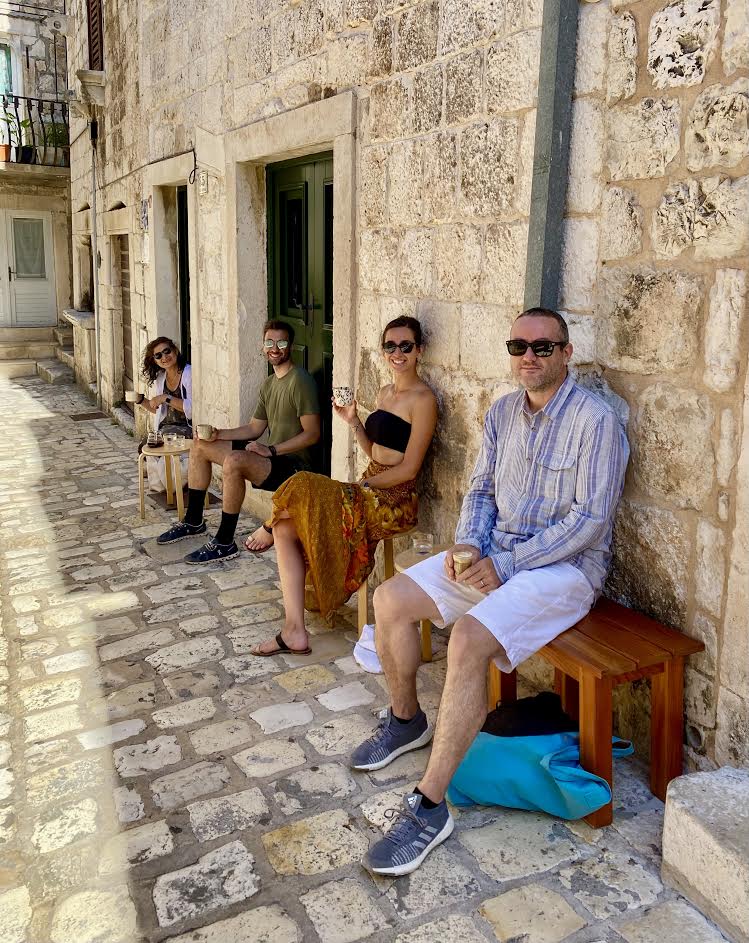
You recently became a TV celebrity - tell us about that experience. You did a great job promoting the digital nomad lifestyle to a domestic audience. I think a lot more people here now understand it better.
Who thought we’d ever be on Croatian TV?! Wow, what a fun experience. We were delighted when the Puls team reached out to feature us in their digital nomad series, and were especially excited to share our positive experiences in Croatia. We shot the film over a few days - at our apartment, in Jelsa & Hvar town, and near Zavala. Filming the reportage is a lovely memory for us, as was spending time with the producers, Maja and Jura. They are a joy to work with and made us feel very comfortable in front of the camera. The reportage captured moments of our everyday life. It also showed that digital nomads can benefit from living in Croatia and that likewise, Croatia can benefit from digital nomads integrating into the community. We are so grateful to the people of Hvar (and Croatia, as a country) for embracing us.
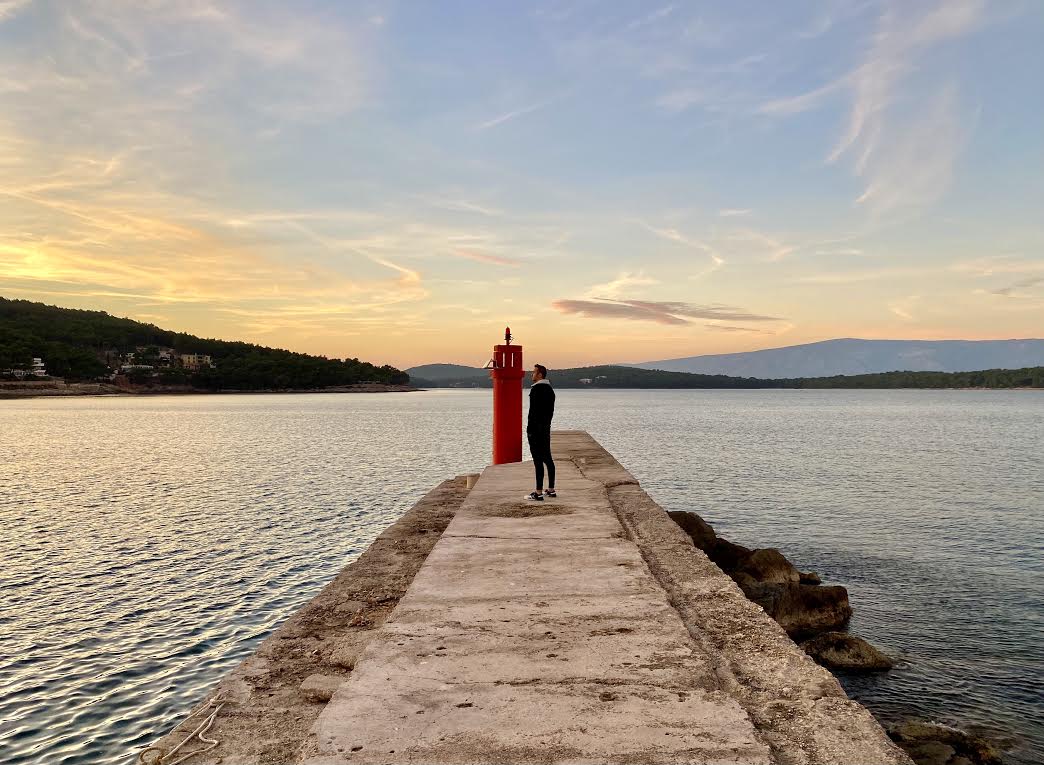
An American on Hvar. That can only happen for a finite length of time, normally, but you had good news come recently - your application for the digital nomad visa has been approved. Congrats! Tell us more.
Puno hvala! It’s exciting to be one of the first people to receive approval for Croatia’s new digital nomad visa. It is rather incredible that Croatia created and approved the digital nomad visa in such a short period of time.
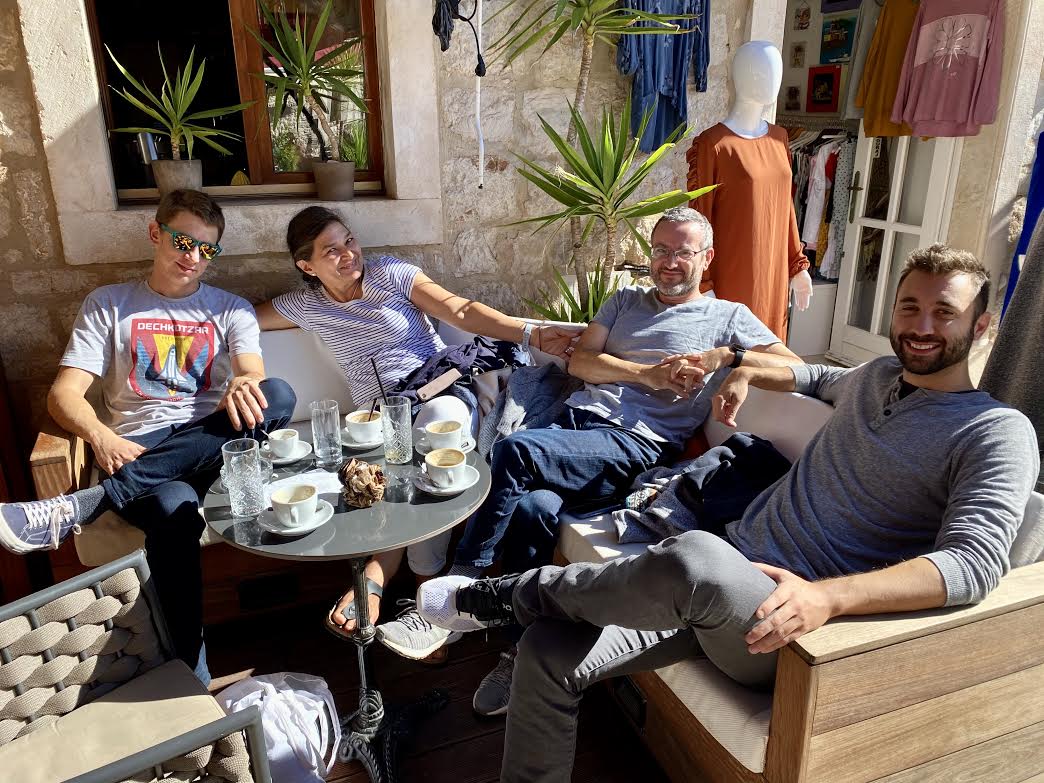
Tell us about the process and what you needed exactly?
Since I had already obtained a temporary residence permit and some of the requirements overlap, the change was relatively simple. I applied shortly after the visa was announced in January and submitted my paperwork through the Hvar police station. Shout out to Ivana for helping us through the process! The digital nomad visa is new for everyone, the MUP and applicants alike, so it felt like we were all learning together. I provided proof of employment (on official company letterhead), proof of health insurance (foreign and travel), proof of income (pay stubs), the completed application form, a copy of my passport and a small photo for the ID. I paid a fee - if I recall correctly, it was 600kn plus 70kn in stamps. I signed a document to request the revocation of my temporary residence permit in order to apply for the new visa. The MUP provided me with a document stating that I was legally in Croatia while ‘between’ visas. The whole process took 4-6 weeks. Big thanks to all of our friends and acquaintances who advised me through the process, including you(!) and Jan de Jong.
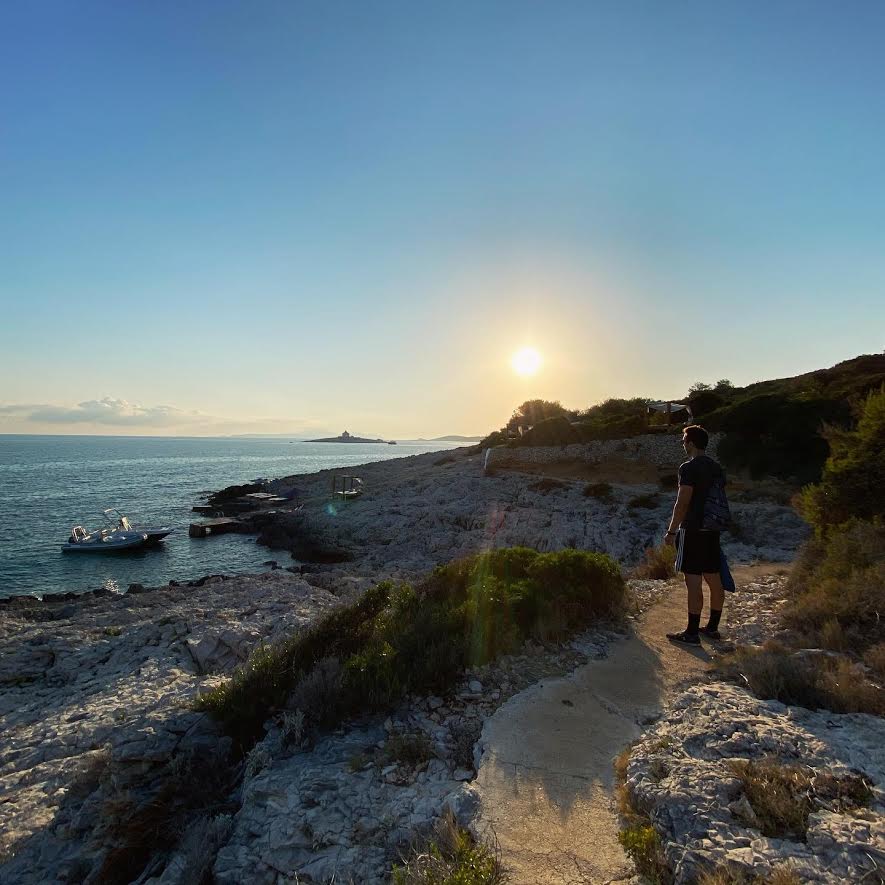
What exactly does it mean for you and your lifestyle to now be able to stay in Croatia for 12 months?
Being able to stay in Croatia for an extended period of time means two big things for me. Firstly, I have more options on the table regarding where I want to live and work. Secondly, it actually provides some stability as we all enter a post-pandemic world. Like many people, my life shifted in 2020 - there were circumstances I couldn’t control but there were choices I could control. One of those choices was to relocate to Europe. My original intent was to stay for a few months and then travel around the continent but I wanted to stay in Croatia. After my tourist visa expired after 90 days, I applied for and was granted a temporary residence permit. The digital nomad visa provides a longer-term solution for staying in Croatia and removes the stress and uncertainty of having to re-apply for extended temporary residence. Now I don’t have to worry about leaving Croatia for a year and can focus on my life and work here. Something I didn’t fully realize before landing in Croatia is that it takes several months to settle into a new place. Getting comfortable with the environment, people, way of life - it all takes time. Having the option to stay for a year gives me the opportunity to more deeply explore the culture and what it would be like to live in Croatia long-term. I wouldn’t be surprised if other digital nomads choose to lay down roots in Croatia - either through starting businesses, buying property or becoming part of the community - because they have the chance to spend sufficient time here before making those decisions.
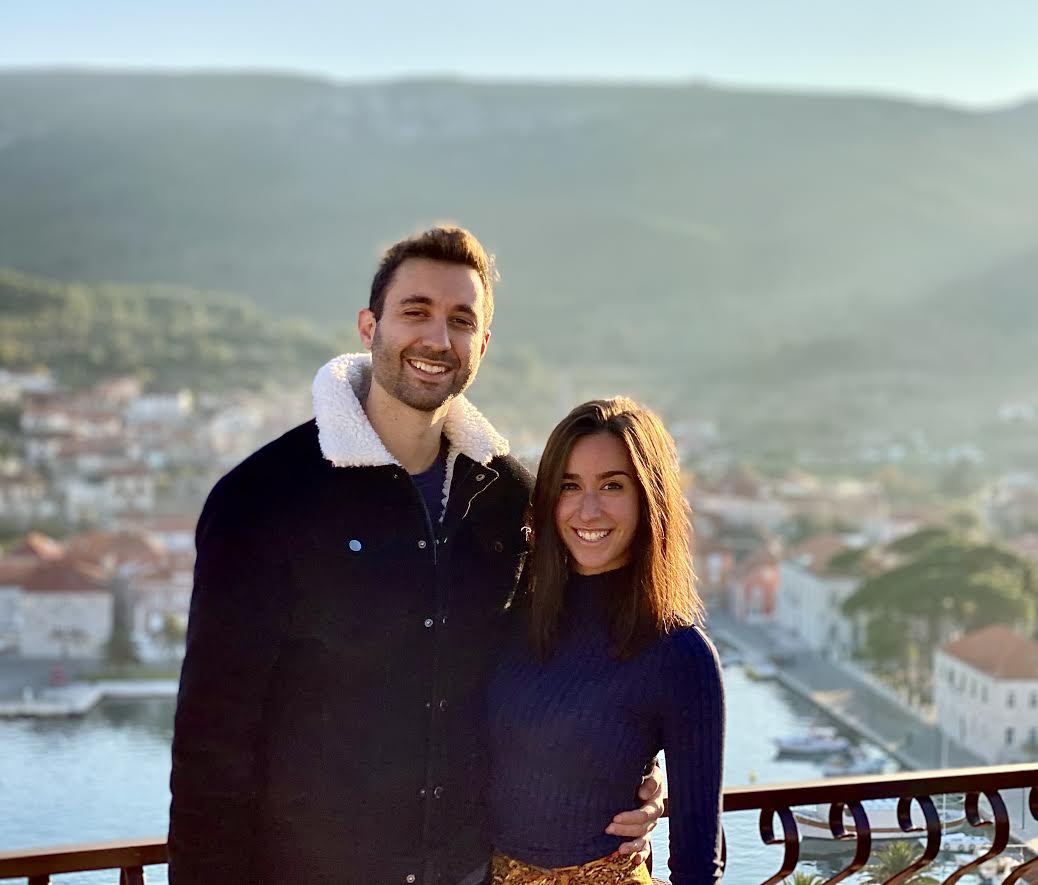
What message do you have for fellow international remote workers about life in Croatia off-season. What are the pros and cons?
Croatia is an excellent option for digital nomads all year-round. It’s worth noting that my perspective is based on spending the majority of my time on Hvar - which is a place that I’ve grown to love and can recommend highly! But from what I know, there are many awesome destinations within the country, and there’s somewhere for everyone. Big cities, tiny villages, and everything in between - as well as over 1000 islands (though not all of them are inhabitable). The landscape varies vastly across the country, from mountains to farmland to (a very long) coastline. I was slightly concerned about being able to find a high-speed internet connection, but it’s not been a problem. Most Croatians I’ve met are willing to speak English, so there is no language barrier in terms of being able to get around and communicate generally. Every location has its perks and quirks - as long as you are determined and have an open mind, you’ll be able to make it work. There’s heightened energy and tangible efforts around making Croatia a premier destination for digital nomads, making it a great place to be right now.
Here is the great feature on Jess and Thibaud which aired on Croatian primetime TV on HRT Puls.
If you want to learn more about their story, they gave a great interview on TCN back in December, when the digital nomad opportunity was still not officially in place. Read Digital Nomad Life in Croatia: Jess and Thibaud, from San Francisco to Jelsa.
That means that there are now at least two Americans in Croatia with the digital nomad visa. Meet the first-ever recipient of the visa - Meet Melissa Paul, Owner of Croatia's First Digital Nomad Visa.
Are you a digital nomad who would like to spend 4 weeks as a guest of the City of Dubrovnik? Learn more in Dubrovnik Launches World's First Digital Nomad-in-Residence Competition.
For the latest news and features about digital nomads in Croatia, follow the dedicated TCN section.
How many Americans in Croatia are there? We are looking to do a series on Americans in Croatia, so if you are here and would like to be featured, please contact This email address is being protected from spambots. You need JavaScript enabled to view it. Subject Americans in Croatia.
Learning Croatian: Dalmatia's Shortest and Most Common Conversation
March 1, 2021 - How hard is learning Croatian really? Take some encouragement from the shortest and most common conversation in Dalmatia - just 4 words!
Having the perfect teacher can enhance your chances of learning a foreign language considerably, and there are no finer teachers than Professor Frank John Dubokovich, Guardian of the Hvar Dialects.
With his expert knowledge and considerable patience (although not as patient as the waiters listening to his 30-second specific way or ordering coffee), I have learned things I never needed to know about Hvar dialect. Fun fact - did you know, for example, that there are 8 different words for 'chisel' on the island of Hvar. The bigger joke, perhaps, is that it is all but impossible to actually buy a chisel on the island.
The Professor is a master at keeping words to a minimum, unless of course, he is ordering that coffee. In terms of mastering the basic Dalmatian greetings, there is nobody who can touch the Professor in terms of making each syllable count. His legendary Dalmatian Grunt, below, quickly went global when it was unleashed on an unsuspecting Internet a decade ago.
More archive footage has emerged of the Professor demonstrating the shortest and most common conversation in Croatia. It is a conversation you hear EVERYWHERE in Dalmatia.
And it is incredibly easy to learn.
One question, one answer, 4 words, 5 syllables. How hard can that be?
The conversation goes as follows:
Di si?
Evo me.
Which literally translates as ('Di' is dialect for 'Gdje')
Where are you?
Here I am.
End of conversation.
Deep.
And there you have it. Along with the grunt, you have greeted your companion, enquired after their health (sort of), and are now free to enjoy the morning newspaper.
When it comes to coffee, however, the Professor has a LOT more to say.
The only footage I have of the Professor ordering a coffee is this video with former Australia Socceroos assistant coach, Ante Milicic, who was so impressed by the Professor's teachings that he has his voice both as his ringtone and wakeup call. And no, I am not kidding.
For more inspiring lessons from the linguistic colossus that is Professor Frank John Dubokovich, visit the TCN Talks YouTube channel.
Croatian TV Showcases the American Digital Nomad Hvar Lifestyle in Jelsa
February 26, 2021 - What happens when you blend American digital nomads with the Hvar lifestyle? As HRT Plus reported last night, it is something close to heaven.
It is rather a strange feeling watching your home on national television with someone else living in it, but what a lovely report from Maja Zrnic for HRT Puls which went out on primetime television last night.
With all this talk of digital nomads, what is the reality like, and how is the Hvar lifestyle for digital nomads from the USA in Jelsa during winter, for example.
A few weeks ago, we published a really great interview with Jess and Thibaud, who have been in Jelsa for a few months and are in the process of applying for the digital nomad visa. You can read the interview in Digital Nomad Life in Croatia: Jess and Thibaud, from San Francisco to Jelsa.
Soon after, Maja contacted me and said that was interested in doing a TV story on the couple. Introductions were made, new friendships forged, and Maja captured the Hvar lifestyle through foreign eyes in this ten-minuted feature, which aired last night. It is almost all in English with Croatian subtitles.
And yes, I did feel a little homesick, not only for the Panorama Penthouse Jelsa apartment that was our home before we moved to Varazdin. But also a little nostalgic for those magical winter months on Hvar.
Maja did a really great job bringing out the Hvar lifestyle in the piece, and it offers a glimpse of how community life can slowly be enriched with the arrival of international digital nomads, who work through their laptops by day (or, in some cases due to time zones, by night) while fully integrating with the local community once work is finished.
Read more about digital nomad life on Hvar in Hvar Digital Nomad Life with Kids: an Emerging Lifestyle.
For more news on digital nomad topics in Croatia, follow the dedicated TCN section.
Hvar Digital Nomad Life with Kids: an Emerging Lifestyle
February 23, 2021 - After a long absence, one of the writing stars of the early days of Total Hvar is back - Ivana Zupan on Hvar digital nomad life with kids, an emerging lifestyle.
Three years ago, after living on Hvar for 10 years full time, I decided that I had to leave. Coming and going to the island was a great way to cope with its many downsides, and it allowed me to enjoy all the good there was. I was able to take my vacation during the summer months, for example. What a no-go for many islanders...
Back then, being a mother of an unschooler, I came to realise that without a like-minded community, I will not be able to keep my lifestyle, so I opted for city life to see if this would work out. We were lucky to find a great community in Bratislava. Our home-schooling study group - DOBROdruzstvo is the warmest, coolest and most amazing place for kids. Its fundamental sense for creating and nurturing relationships between people, building responsibility in our children’s own education, and emphasis on cooperation and solution finding is something which means a lot to me and to my daughter. I feel blessed and grateful for being a part of it for the last year and a half. The study group has a base in Bratislava, with a nice 'school' building and an outdoor space. Allowing the kids to come together and interact in a respectful environment. So it was, until recently.
In today’s world, there is probably not a country, where COVID measures would not affect our lives. There are different approaches with different results, some countries tend to be more strict than others, and the effects of such measures have been much debated. Slovakia is one of the countries where measures can be easily described as a Nazi-like experimentation camp. Forced COVID-testing once per week, or you are not allowed to go to work, to the bank, to the post office, send your kids to school etc. Not to mention, that masks are mandatory outdoors.
When this testing-madness was introduced back in October last year, I felt so angry as I was watching democracy in my homeland taking this huge slap in the face. More so that people were being obedient and supported it by attending the mass-testing. Very few of us found the strength to rebel against this blackmailing approach. Not an easy task in such a suffocating atmosphere, I must admit. I managed to stay sane by focusing on keeping our little homeschooling community going. Feeling that by continuing to create something new, while the old system was crashing down was the best I can do, given the circumstances.
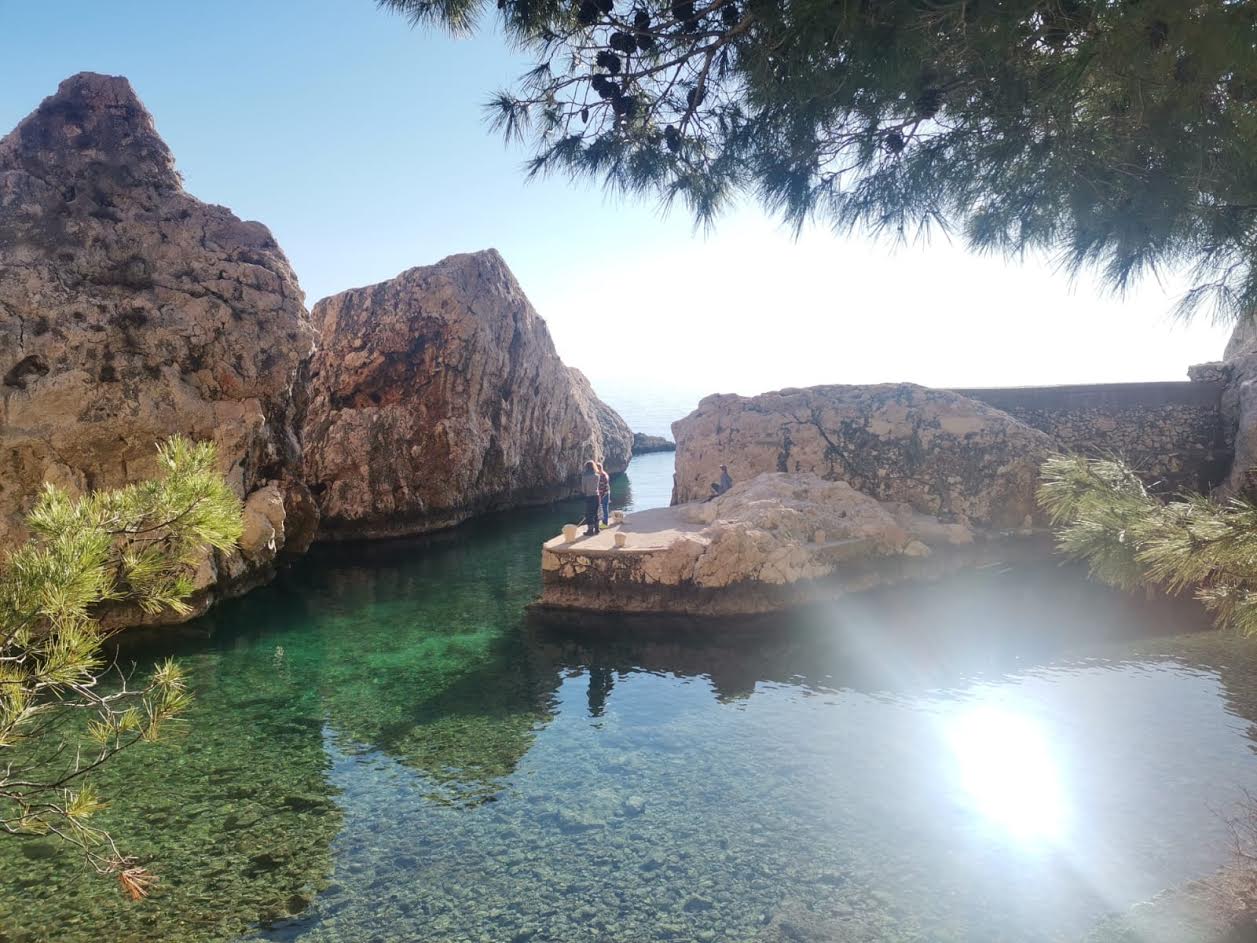
(A haven for kids to play hide and seek. Photo: Mgr. Daniela Bohata)
Now we are back on Hvar. For two months now. I decided not to play along with the once-per-week-COVID-testing-or-you-are-not-allowed-to-live game. Back to unschooling. Looking for a small community with a few kids to join forces with other parents. Spending a lot of time outdoors with the kids. We are rediscovering the island and its hidden gems – like the Cliffbase in Sv. Nedjelja, where Katarina is slowly creating a digital nomad community. I hear there are still a few spots available.
The weekend trip to Cliffbase left me amazed about what a dedicated man can create at the end of the world. A wine cellar literally carved by hand in these huge rocks, just to name one. Miro Štec spent the last 20 years building this place. A lot of love and hard work went in.
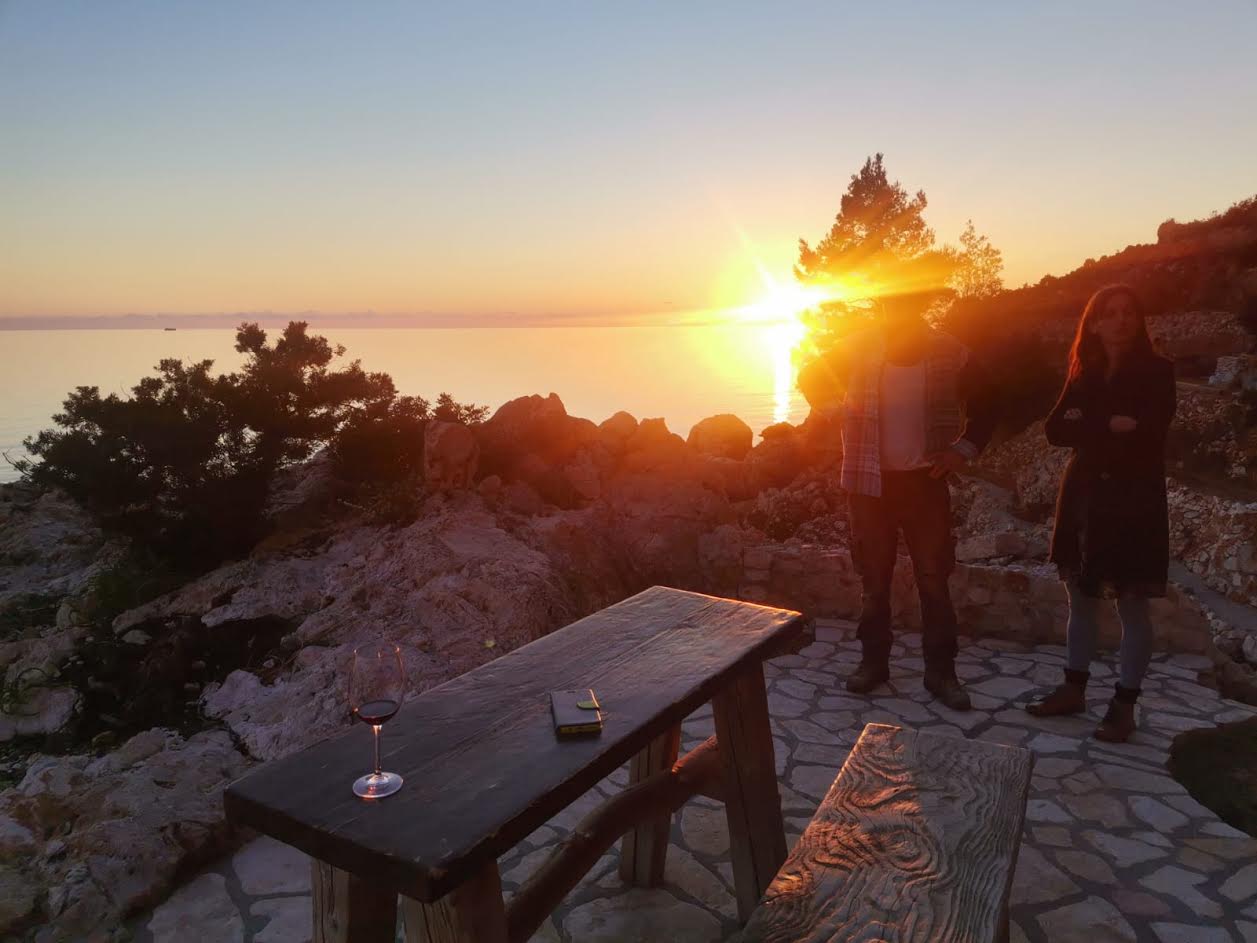
(A sunset at the Cliffbase in Sv. Nedjelja on Hvar. Photo: Mgr. Daniela Bohata)
I am not a climber, but I imagine it must be a heaven for them too. Not to mention I wanted to be 10 again to be able to play there at all those big rocks and hidden caves. Swimming in February, sharing food and stories with other mums. The flow there was simply perfect.
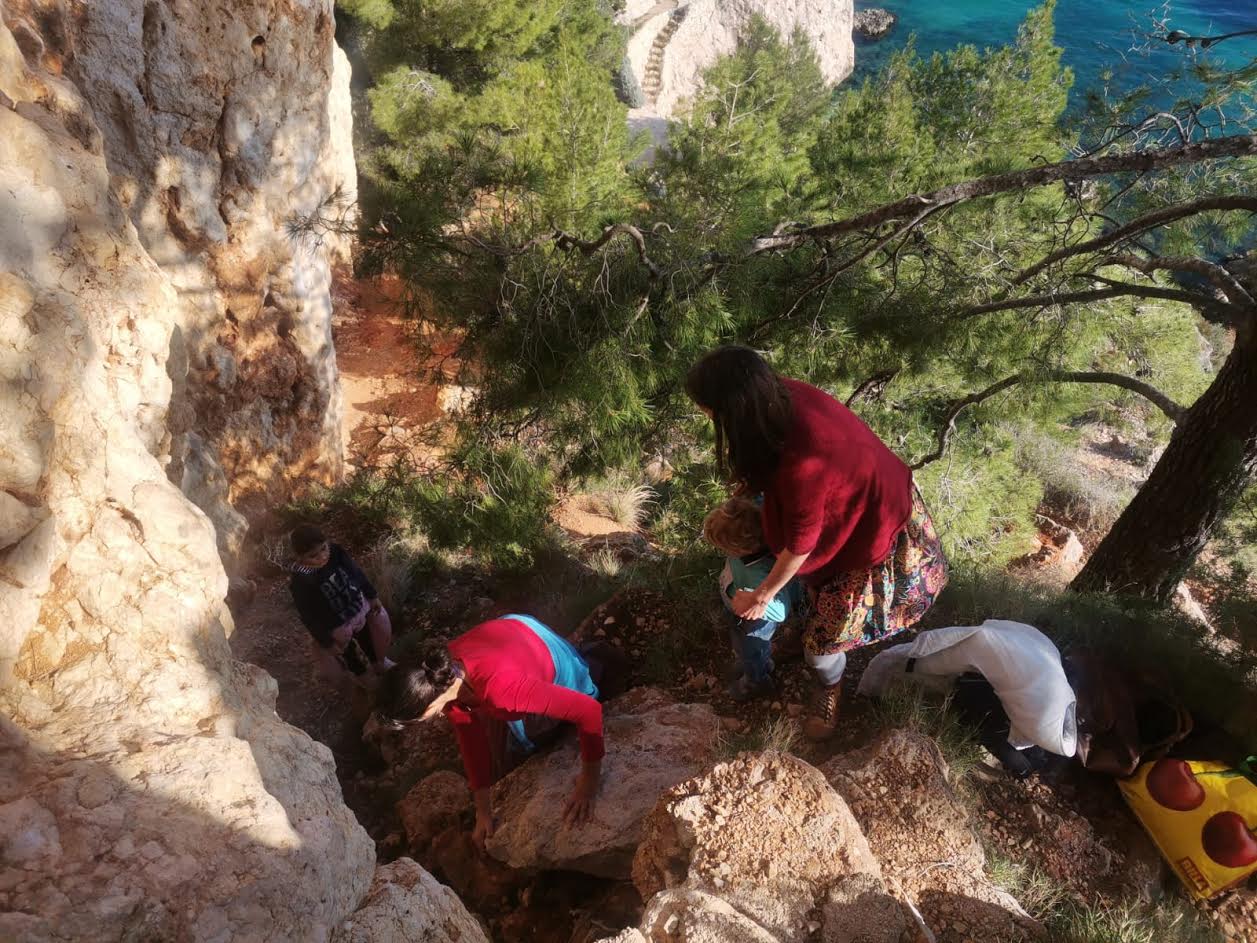
{The steep path was a bit of a challenge for us, mothers, but the good old-fashioned cooperation helped, and we managed. Photo: Mgr. Daniela Bohata)
Daniela, the author of the beautiful photos came all the way from Makarska and now we are thinking about repaying her the visit and might be exploring Biokovo the next weekend. Let’s see how that one goes. In the meantime, you can find more about her work as a tour guide on her website.
If last year taught me something, it was not to plan that much. A huge lesson for me - the organised one. But, slowly, I am getting used to it - not knowing how this will progress, I am enjoying what I can while I can. So, here it is, a call to all digital nomads with kids out there. If on Hvar, get in touch.
If you are digital nomads with kids and planning on a stay on Hvar and would like to contact Ivana, email us on This email address is being protected from spambots. You need JavaScript enabled to view it. Subject Hvar kids.
People from all over the world are already enjoying the Hvar digital nomad lifestyle. Read more in Digital Nomad Life in Croatia: Jess and Thibaud, from San Francisco to Jelsa.
The Croatian government has now published guidelines on how to apply for the Croatian digital nomad visa.
Meet Melissa Paul, Owner of Croatia's First Digital Nomad Visa.
Circular Economy on Islands Lags Due to Low Environmental Awareness
February 17, 2021 – In a video podcast entitled "Energy Transition on the Islands," organized by the Island Movement initiative, participants warned that underdeveloped environmental awareness is one of the main obstacles to implementing the circular economy on islands.
As Hina reports, the deputy mayors of Hvar and Cres warned that citizens are still unaware of the green economy's importance, which makes it challenging to introduce a circular economy on islands.
"The most difficult phase in achieving sustainable development is to explain to ordinary citizens why the energy transition would be a step forward," said Marin Gregorović, deputy mayor of Cres.
The circular economy is a production and consumption model that encourages sharing, borrowing, reuse, repair, recovering, and recycling of products and materials to achieve the product's added value. Such a concept has a positive effect on reducing the amount of waste.
Commenting on the inefficient disposal of waste on the islands, Gregorović noted that "the system is not working well" and that "we have not yet reached the stage of resolving the issue of biowaste disposal."
"Although we have a recycling yard and dual waste management on Cres, and we plan to build a composting plant, the story of the circular economy is still just – a story," said Gregorović.
Kuzman Novak, deputy mayor of Hvar town, added that "the fundamental problem at the national level is waste management."
"We take the garbage bags out of the house, and they are taken away, which we don't see, so we don't think they are our concern anymore. That is the key problem," Novak said, explaining the underdeveloped environmental awareness of citizens.
"When we talk about sustainable development, it's not just about solar power plants and waste management, it's essentially developing an awareness not to be selfish," said Novak.
The new EU Action Plan for the Circular Economy is one of the key elements in achieving climate neutrality, which is a central goal of the European Green Plan. Voting on the new EU circular economy action plan, the European Parliament this month called for additional measures to achieve a carbon-neutral, environmentally sustainable, and fully circular economy by 2050.
To read more about lifestyle in Croatia, follow TCN's dedicated page.
Snow on Hvar! And the Truth Behind 'Free Hotel When It Snows' Legend
February 13, 2021 - Snow on Hvar is always a national media event, and so it proves today. But are the hotel stays really for free?
One of the first things I heard when I came to Hvar for the first time was that it had the best climate in Europe. And over the 13 years I lived there full-time, I certainly had no complaints (but then I am a Manchester boy, born in the rain, whose boarding school is in the Guinness Book of Records for most rainy days in one year - 332 days...).
Apparently, the hotels would give you a free hotel room if it snowed, so confident were the hoteliers in the island's unbeatable weather. A great marketing trick, I thought to myself, as snow only falls in winter when there are no tourists.
Of course, the moment I got off the ferry having driven all my stuff to my new home from Oxfordshire, some funny white stuff started falling from the sky around Stari Grad. I have been blamed for any bad weather on Hvar ever since.
But nothing was like February 4, 2012 (see lead photo) when we awoke to find Jelsa covered in a blanket of white. We had business in Hvar Town that day. Driving in 4-wheel drive through the snow on the main road was surreal, but not as surreal as watching a snow plough coming in the opposite direction. On Hvar!
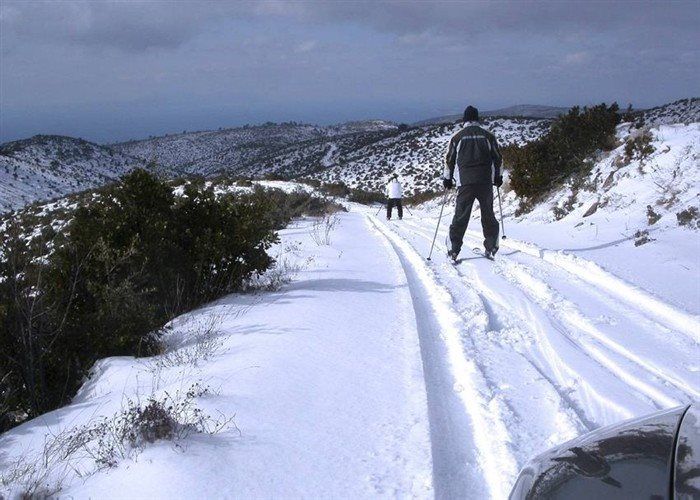
People even skied from the top of Hvar to the beach at Dubovica - read the full story.
I was amazed. How was it possible, with Dalmatian covered in snow and ice, that someone could spare a snow plough to send to Hvar? Upon investigation, it turned out that the sunshine has its very own snow plough, which is operated by the chap who owns the restaurant in Vrbanj. He must have less work than Santa Claus.
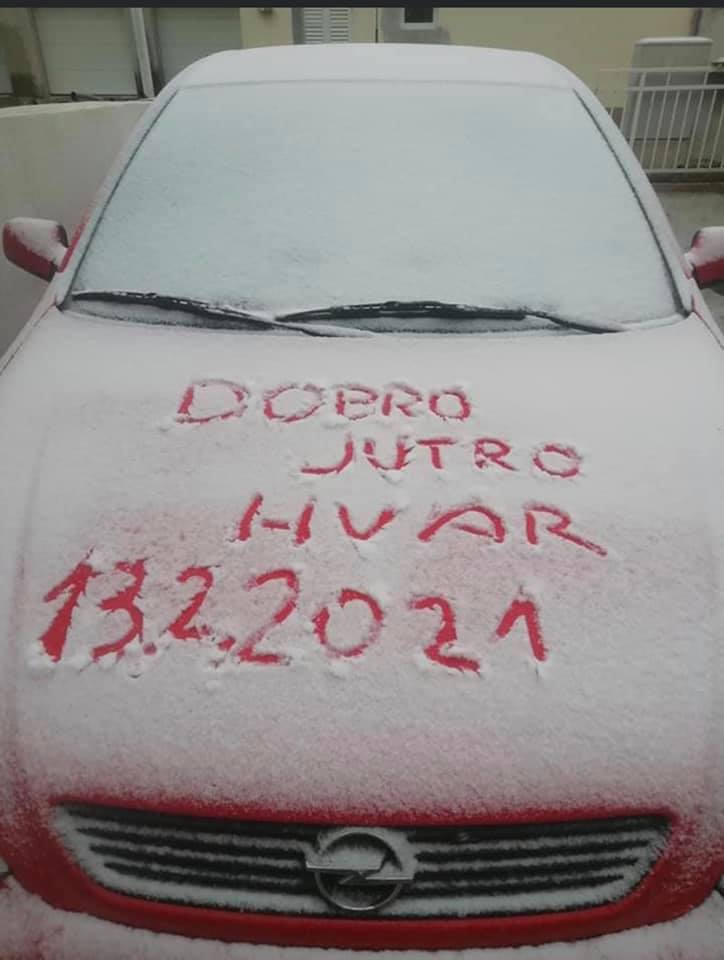
(HVAR Facebook page)
Snow fell once again today, as in much of Dalmatia, a moment which always causes excitement with the local kids, and locals mark the event in their own special ways.
So are the hotels actually free? It was something I decided to chase up back in 2012 and I asked Suncani Hvar Hotels what the official policy was. The reply was that if it had been snowing for 7 days then guests could get the 8th day free.
Not quite the same thing.
Some years later, I chanced upon what appears to be the origins of the claim, in a 1960s video of Dalmatia. Here is what was advertised on Hvar.
(YouTube screenshot)
1. 50% reduction if it rains more than three hours between 7 am and 5 pm
2. Free stay for each snowy day
3. Free stay for each foggy day
And a free stay if the temperature drops below a certain temperature (0 degrees).
I wonder if they are still valid in 2021...
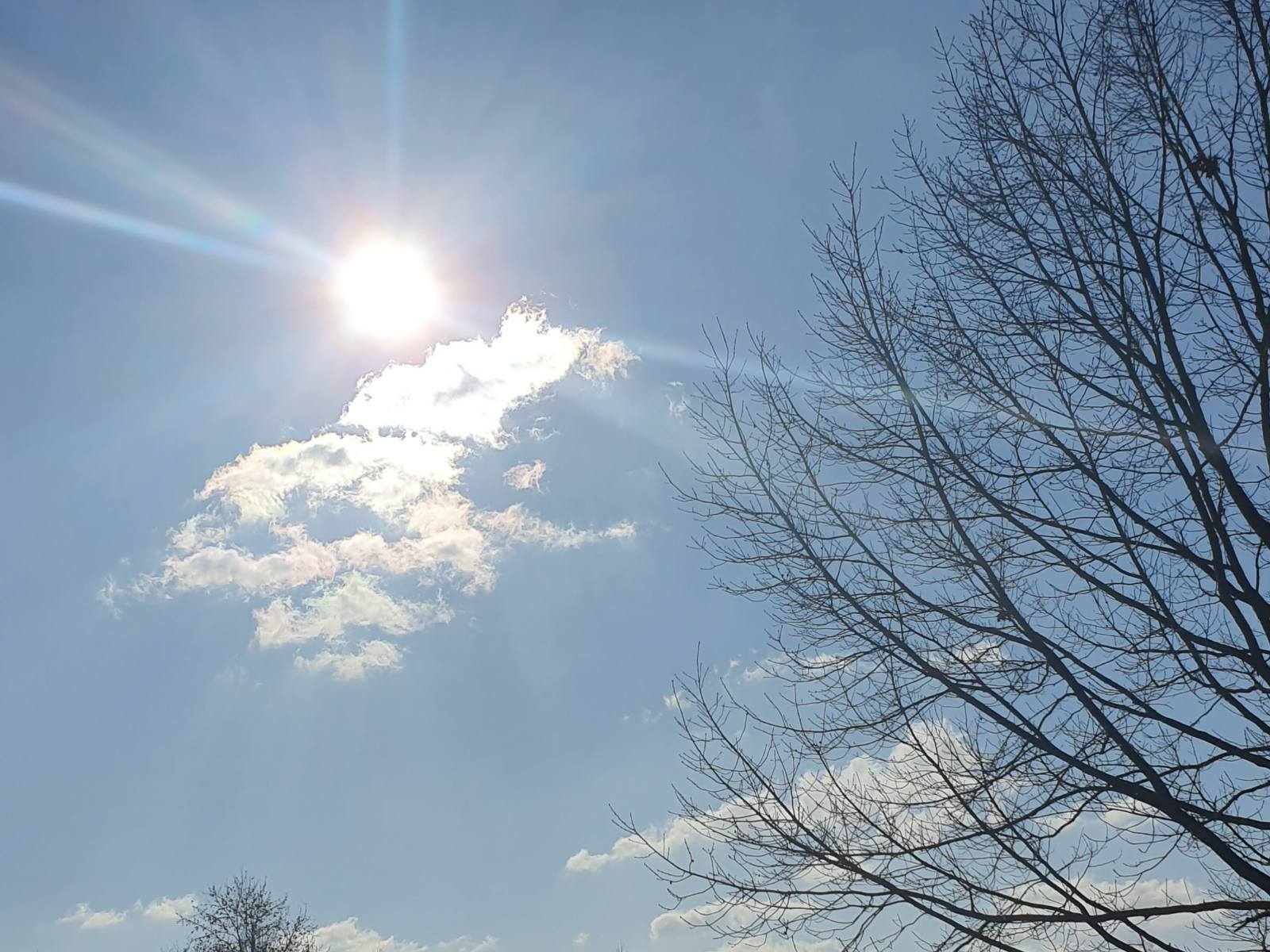
(A sunny day in Varazdin - Photo by Taliah Bradbury)
Meanwhile, the morning started wonderfully in Varazdin this morning. People thought I was crazy to move from the sunshine island to the cold and forbidding north of Croatia.
For more news about the island of Hvar, follow the dedicated TCN Hvar section.
Learning Croatian: Articles of Clothing in Hvar Dialect (VIDEO)
February 13, 2021 - Continuing our look at the Croatian language through Hvar dialect, some important things to know about articles of clothing, with a cameo appearance from a famous winemaker.
Learning Croatian on a Dalmatian island is not recommended, unless you find a teacher who can teach you classic Croatian rather than the local dialect. It was a lesson I learned at great cost when I went to Zagreb some time later, only to find out that my shiny new Croatian words were actually unintelligible to most people who were not from Hvar.
Add to that the famous Dalmatian Grunt, perfected by the one and only Frank John Dubokovich, and the concept of a video series on Hvar dialect was born. As previously mentioned, the original YouTube series dating back to 2011 was taken down for some reason, but some of it has survived on an old camera.
Today's lesson is probably my favourite, focusing on articles of clothing in Hvar dialect. Over the years, the lessons achieved something of a cult status on Jelsa's main square, and various people were quick to add their expertise, sometimes even to contradict the great Professor Frank John Dubokovich, Guardian of the Hvar Dialects.
The other problem, which was probably linked to the number of cold ones consumed prior to recording, was that filming (always one take only) often coincided with the ringing of the midday church bells. This week's episode descended into chaos, with a combination of those bells, as well as the linguistic intervention of the Three Wise Men, including legendary Jelsa winemaker, Andro Tomic.
You can subscribe to the TCN Talks YouTube channel for the latest language instructions from The Professor.
For the latest news from the island of Hvar, check out the dedicated TCN Hvar section.
Looking to improve your Croatian as a foreigner? 25 Mistakes Foreigners Make When Speaking Croatian.
Hvar Covered in Snow This Morning Again After Three Years
February 13, 2021 – Have you ever imagined the Croatian island of Hvar covered in snow? It sounds unbelievable for one of the sunniest islands in the Mediterranean, but today it snowed again in Hvar, just like three years ago.
The announced cold front arrived in Croatia, and even in its warmest parts. Even the Croatian island of Hvar was covered in snow this morning.
Three years ago, one of the sunniest islands in the Mediterranean was covered by snow for the first time in 25 years. This morning, the Hvar town people woke up just like in 2018 – seeing their city covered with a thin white blanket.
"It's always nice to see a little bit of winter joy because we don't see it often. We are not used to this, but let it last for a few days. We will endure the cold," said Vedran Dulčić, Hvar native, who sent us a photo from the town of Hvar.
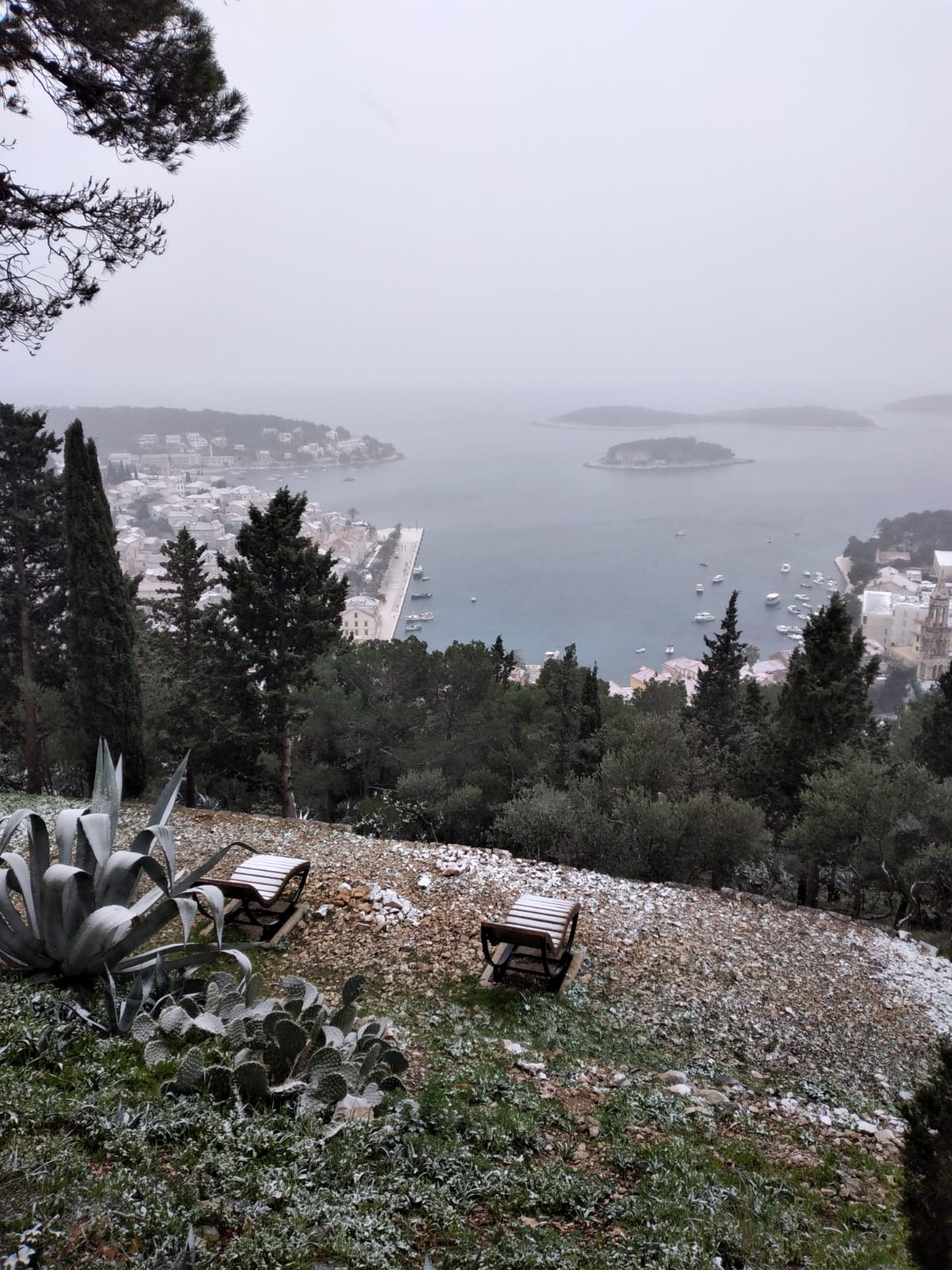
A view from Hvar Fortress (Fortica), an unavoidable place in Hvar, looks like this today. The Hvar port, perfect blue sea, and Pakleni islands in the background, which a beautiful view overlooks during the summer, are now barely even seen.
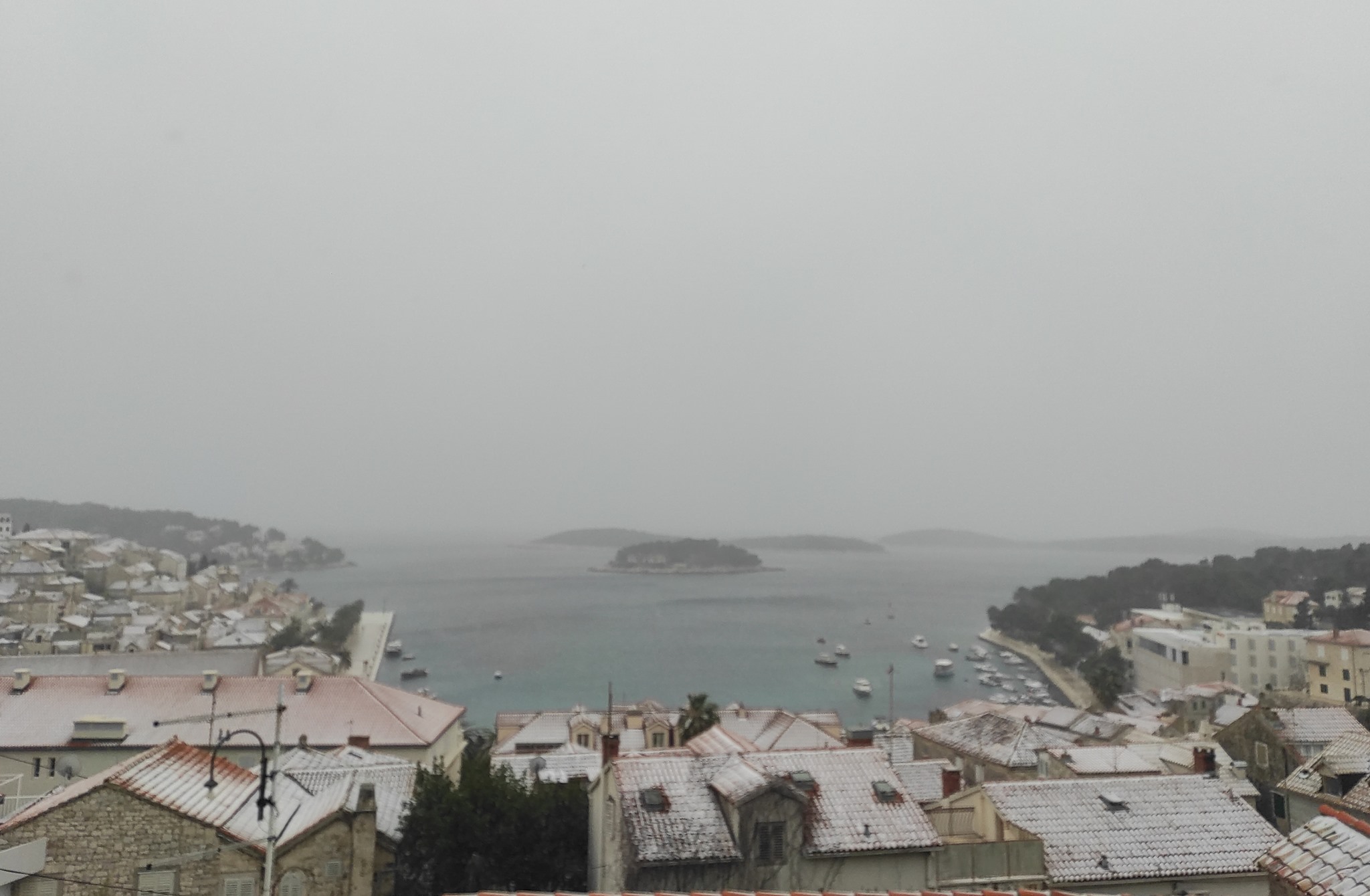
Facebook Hvar Town
It's also very cold. Hvar residents say that the stormy wind bura started to blow, and they predict (or at least hope) that the snow will not last long. By midday, it already almost melted. However, in 2018, the snow on Hvar stayed for more than a week.
For people who are used to temperatures above 30 degrees Celsius on Hvar, today's only one degree is not pleasant at all, but they try to endure it. Just a few more months and there will be summer, right? Although it is beautiful even in winter conditions, nothing can compare to the beauty that Hvar exudes in summer.
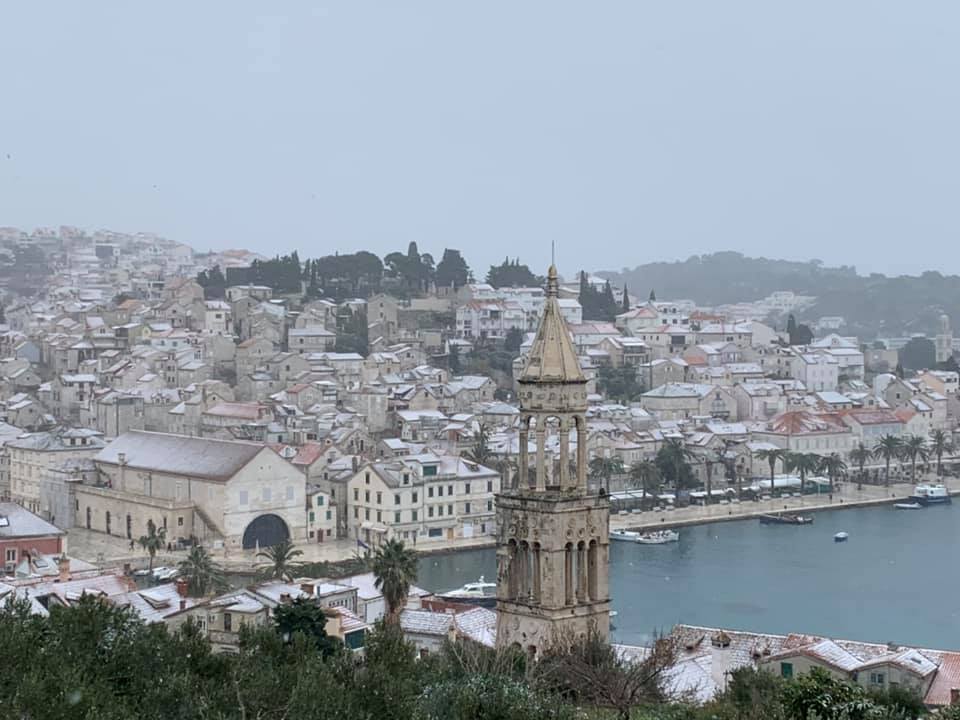
Facebook Secret Hvar travel agency
For the latest travel info, bookmark our main travel info article, which is updated daily.
Read the Croatian Travel Update in your language - now available in 24 languages.
Plastic-Free Croatia: Croatian Cities and Islands Moving to Reduce Plastic Waste
February 7, 2021 - Dubrovnik, Trogir, Stari Grad on Hvar, and Sali on Dugi Otok will be the first in Croatia to reduce plastic waste and use alternative solutions by participating in projects implemented by the Split Association "Sunce" for Nature, Environment, and Sustainable Development, setting the pace for a plastic-free Croatia.
Glas Istre reports that "Plastic Smart Cities Croatia" and "For Plastic Free Croatian Islands" aim to reduce plastic waste and use alternative solutions. They analyze the use of disposable plastics and waste plastic management in the local communities involved, develop and implement a "Plastic-Free Plan" with a participatory approach and workshops, as well as organize "plastic-free" public events, i.e., events and public forums aimed at raising awareness in the local population about the consequences of plastic pollution.
One of the important activities is implementing a national campaign to raise awareness of the impact of plastic pollution on the marine environment and available sustainable solutions in the island communities on Hvar and Dugi Otok. The Split Association for Nature, Environment and Sustainable Development "Sunce"is currently working on organizing workshops for networking partners and environmental organizations engaged in this topic.
It is in this project that the pioneer association "Sunce" began implementing the projects "Plastic Smart Cities Croatia" and "For Plastic Free Croatian Islands" to reduce the plastic footprint in various segments of social life in local communities by reducing the use of disposable plastic and encouraging the use of alternative solutions for plastic waste. One of their project goals is to raise the awareness of citizens and the public about plastic waste.
After the completion of the project, a final conference will be held aimed at disseminating the project results and encouraging the further reduction of plastic waste for representatives of local island authorities, national and international NGOs, local government units, representatives of the Croatian Chamber of Commerce, tourism, relevant ministries, and other stakeholders, with the message "Reduce the use of disposable plastics and look for more sustainable solutions!", which the Sunce Split Association has been advocating for many years.
They remind that a new Law on Waste should be adopted in Croatia this year, which, among other things, contains some provisions of the EU Directive on reducing the impact of certain plastic products on the environment. At the end of last year, independently and in cooperation with other environmental protection associations in Croatia, they sent their comments on the Waste Act's draft proposal.
They add that the European organization "Seas at Risk," which brings together several associations dealing with protecting the marine environment, assessed last summer that the EU directive is an ambitious plan to dispose of ten non-reusable plastic items, and which can most often be found on beaches across Europe, but that its implementation into national legislation in most European countries has been halted.
The COVID-19 crisis has led to a dramatic increase in the use and the rejection of disposable plastic objects in nature.
"The Mediterranean Sea is one of the world's most polluted seas, and half of this enormous amount of waste comes from the mainland. With 400 kilotons of waste generated annually, Croatia ranks third in the region. Hence, it is imperative to take urgent measures and raise awareness to numerous visitors about the need for urgent action, i.e., reducing disposable plastic use.
Namely, tourism has been identified as one of the key actors, so part of the awareness campaign within the "Plastic Smart Cities" project is aimed at foreign and domestic tourists, the Sunce Split Association points out.
The EU directive on plastic waste was adopted in 2019 after a trialogue, i.e., negotiations between the European Parliament, the Commission, and the EU Council. This year, all EU countries must finally implement it. The Law on Waste in Croatia should be adopted by July 3 at the latest. Croatia should also throw out disposable plastic products, namely plastic q-tips, cutlery, plates, straws, drink sticks, and balloon holders.
After adopting the directive in the European Parliament, the then Croatian MEP Davor Škrlec from the Green Group said that the directive should be used to encourage change for us as a society to produce less garbage and become sustainable.
"If we do not change our attitude towards production, consumption, and waste, the human species will become consumable like a disposable coffee cup. This directive will help us abandon disposable plastics on the road to less consumption, better designed reusable products, more innovation, and a cleaner environment," Škrlec said then.
The directive also includes provisions for the disposal of cigarette butts, which are a significant polluter, the objectives of collecting beverage bottles, and the requirement to redesign beverage stoppers to connect them to bottles. The directive also includes national targets for reducing the consumption of plastic cups and food containers, and ultimately a total ban on oxo-degradable plastics often referred to as biodegradable but in reality fragmented into microplastics.
Disposable plastic products and fishing gear together account for 70 percent of Europe's marine litter, so it is expected that Europe's seas will be significantly cleaner by implementing the directive.
According to the Commission, the directive will bring many benefits for the environment and the economy. Environmental damage would be avoided, costing €22 billion by 2030, and saving consumers up to €6.5 billion, with an adjustment cost estimated at €3.2 billion for manufacturers.
At the end of last year, the Commission adopted new rules on the import and ban on exports of plastic waste to third countries that do not have the capacity to manage it in a sustainable way, which is one of the main points of the European Green Plan and EU Circular Action Plan.
To read more about lifestyle in Croatia, follow TCN's dedicated page.


